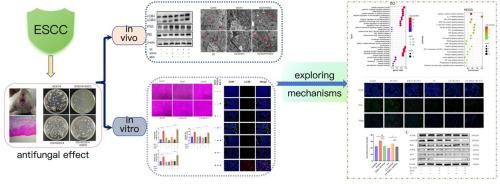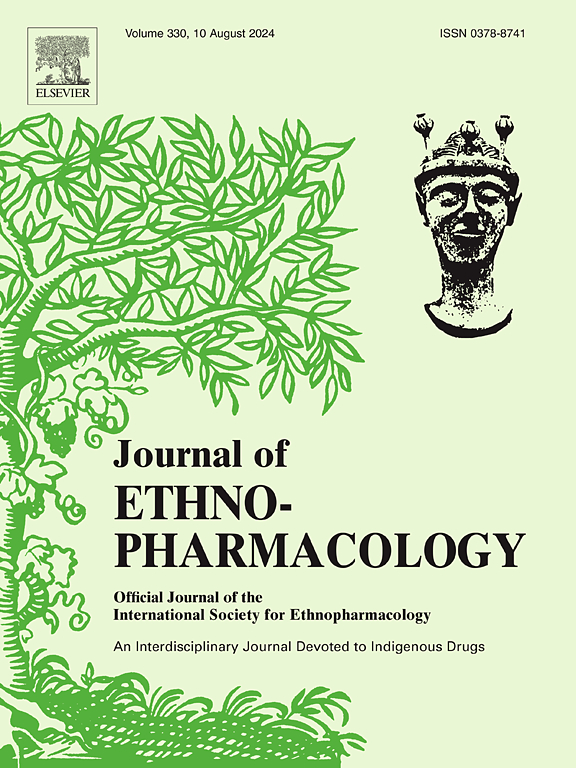Extract of Sophorae Flavescentis Radix-Cnidii Fructus couplet medicines alleviates Candida albicans-induced vulvovaginal candidiasis by activating PI3K/AKT/mTOR pathway-mediated autophagy in vaginal epithelial cells
IF 5.4
2区 医学
Q1 CHEMISTRY, MEDICINAL
引用次数: 0
Abstract
Ethnopharmacological relevance
The combination of Sophorae Flavescentis Radix (Ku Shen) and Cnidii Fructus (She Chuang Zi) has been widely documented in traditional Chinese medicine (TCM) formulations, demonstrating notable antibacterial, anti-inflammatory, and immunomodulatory properties.
Aim of the study
This study aims to investigate the therapeutic efficacy and mechanistic of the extract of Sophorae Flavescentis Radix-Cnidii Fructus couplet medicines (ESCC) against vulvovaginal candidiasis (VVC) induced by Candida albicans.
Materials and methods
A murine model of VVC was established to evaluate vaginal fungal burden and inflammatory cytokine levels, while autophagy-related protein expression and RNA transcriptional profiles were systematically analyzed. A431 cells were used to assess autophagy responses after infection with C. albicans SC5314. Immunofluorescence, quantitative real-time PCR (qRT-PCR), and Western blotting (WB) were utilized to quantify autophagy-related protein expression and transcriptional activity in both murine tissues and A431 cells. Network pharmacology analysis was conducted to predict potential therapeutic targets, followed by in vitro validation of key protein expression levels in the PI3K/AKT/mTOR signaling pathway.
Results
In vivo, 120 mg/kg ESCC treatment restored vulvar symptoms to physiological levels in murine models, with the ESCC group exhibiting a significant reduction in vaginal fungal burden. ESCC upregulated LC3B, ATG5, and p62/SQSTM1 expression in vivo and in vitro, reversing the autophagy inhibition caused by C. albicans. Network pharmacology and KEGG enrichment analyses identified the PI3K/AKT/mTOR pathway as a pivotal mechanism, which was further verified by transcriptional and protein-level assays showing that ESCC promoted autophagic flux through pathway inhibition.
Conclusion
ESCC alleviates C. albicans–induced VVC by activating PI3K/AKT/mTOR-mediated autophagy in vaginal epithelial cells, providing a mechanistic basis for its antifungal and supporting its potential as a plant-derived therapeutic.

苦参-蛇床子联药提取物通过激活PI3K/AKT/mTOR途径介导的阴道上皮细胞自噬,缓解白色念珠菌诱导的外阴阴道念珠菌病。
民族药理学相关性:苦参和蛇床子的组合在中药配方中被广泛记载,具有显著的抗菌、抗炎和免疫调节作用。研究目的:探讨苦参-蛇床子联药提取物(ESCC)对白色念珠菌诱导的外阴阴道念珠菌病(VVC)的治疗作用及机制。材料和方法:建立小鼠VVC模型,评估阴道真菌负荷和炎症细胞因子水平,系统分析自噬相关蛋白表达和RNA转录谱。A431细胞被用来评估感染白色念珠菌SC5314后的自噬反应。利用免疫荧光、实时荧光定量PCR (qRT-PCR)和Western blotting (WB)技术定量小鼠组织和A431细胞中自噬相关蛋白的表达和转录活性。通过网络药理学分析预测潜在的治疗靶点,然后体外验证PI3K/AKT/mTOR信号通路中关键蛋白的表达水平。结果:在体内,120 mg/kg ESCC治疗使小鼠外阴症状恢复到生理水平,ESCC组阴道真菌负荷显著减少。ESCC在体内和体外上调LC3B、ATG5和p62/SQSTM1的表达,逆转白色念珠菌引起的自噬抑制。网络药理学和KEGG富集分析确定PI3K/AKT/mTOR通路是关键机制,转录和蛋白水平分析进一步验证了这一点,表明ESCC通过通路抑制促进自噬通量。结论:ESCC通过激活PI3K/AKT/ mtor介导的阴道上皮细胞自噬来缓解白色念珠菌诱导的VVC,为其抗真菌提供了机制基础,并支持其作为植物源性治疗药物的潜力。
本文章由计算机程序翻译,如有差异,请以英文原文为准。
求助全文
约1分钟内获得全文
求助全文
来源期刊

Journal of ethnopharmacology
医学-全科医学与补充医学
CiteScore
10.30
自引率
5.60%
发文量
967
审稿时长
77 days
期刊介绍:
The Journal of Ethnopharmacology is dedicated to the exchange of information and understandings about people''s use of plants, fungi, animals, microorganisms and minerals and their biological and pharmacological effects based on the principles established through international conventions. Early people confronted with illness and disease, discovered a wealth of useful therapeutic agents in the plant and animal kingdoms. The empirical knowledge of these medicinal substances and their toxic potential was passed on by oral tradition and sometimes recorded in herbals and other texts on materia medica. Many valuable drugs of today (e.g., atropine, ephedrine, tubocurarine, digoxin, reserpine) came into use through the study of indigenous remedies. Chemists continue to use plant-derived drugs (e.g., morphine, taxol, physostigmine, quinidine, emetine) as prototypes in their attempts to develop more effective and less toxic medicinals.
 求助内容:
求助内容: 应助结果提醒方式:
应助结果提醒方式:


